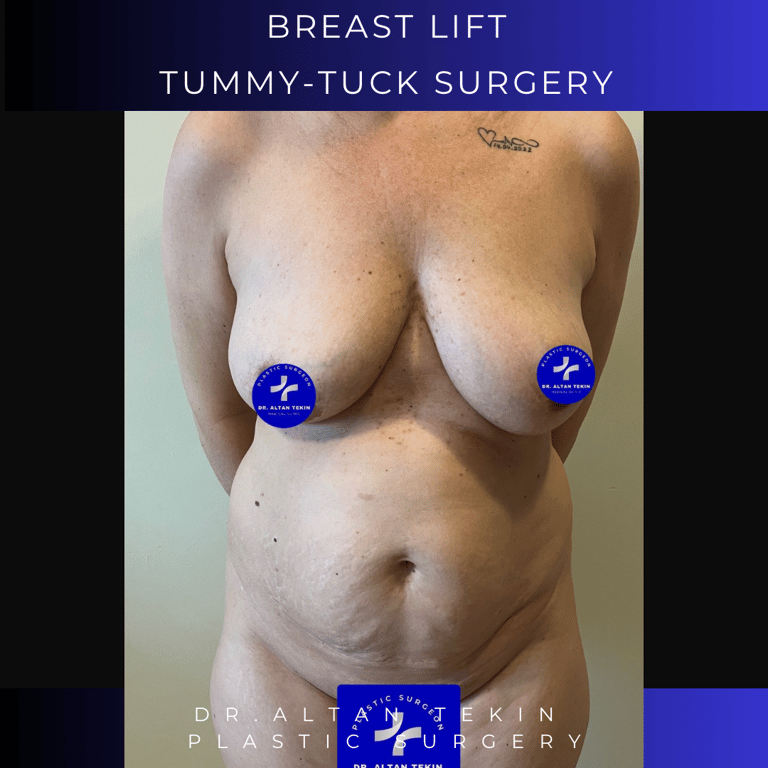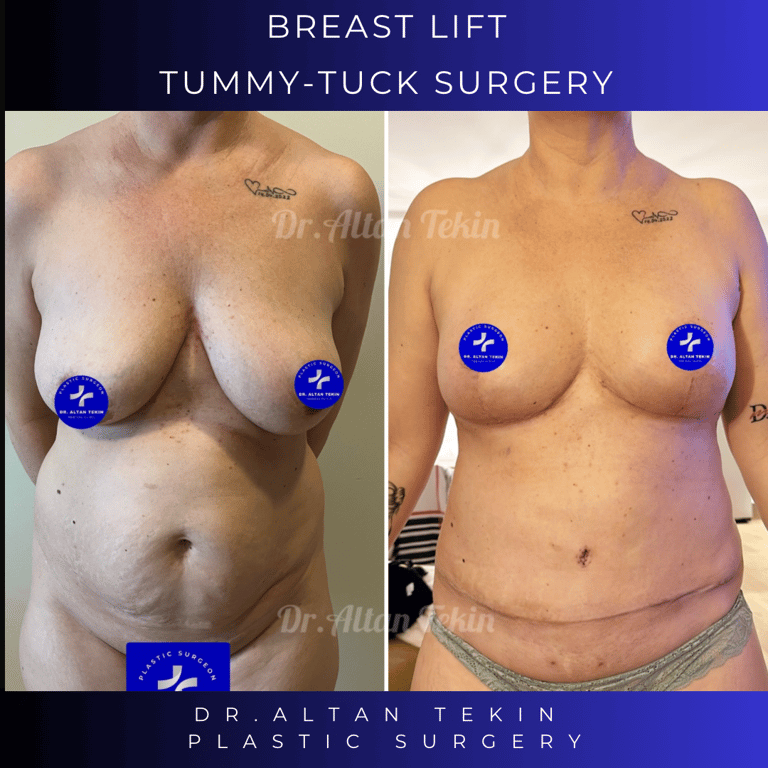CONTACT US: +90 544 138 84 64
BREAST REDUCTION SURGERY
The best plastic surgeon at breast reduction in Antalya.



WHAT IS BREAST REDUCTION SURGERY? WHO IS IT PERFORMED ON?
Breast reduction surgery is a surgical procedure for the treatment of what is medically called breast hypertrophy. Breast hypertrophy is a condition in which the breast tissue is larger and heavier than normal. This condition can cause physical discomfort, pain, back and neck pain and can negatively affect the quality of life.
Breast reduction surgery aims to reduce the size and weight of overly large breasts. During this surgery, excess breast tissue and fat are removed, the breast shape is corrected and the nipple and nipple area can also be reshaped. The surgery requires a recovery period and usually the patient feels smaller, lighter and more comfortable.
Breast reduction surgery may be considered for the following conditions:
Physical Discomfort: Excessively large breasts can cause back, neck and shoulder pain. There may even be skin irritation from the breast straps.
Activity Restrictions: Excessively large breasts can limit sports and physical activities, which can affect a person's lifestyle.
Posture Problems: Excessively large breasts can lead to posture disorders.
Skin Problems: Skin problems may occur due to moisture accumulation and irritation in the skin area under the breast.
Psychological Effects: Excessive breast size can affect a person's self-confidence and cause psychological problems.
Psychological Effects: Excessive breast size can affect self-esteem and cause psychological distress.
The best candidates for breast reduction surgery are those who experience physical discomfort and can tolerate the postoperative recovery process. However, since each patient is different, the necessity and suitability of surgery should be determined after a detailed evaluation by a plastic surgery specialist.


What should be considered after breast reduction surgery?
For patients who have undergone breast reduction surgery, there are a few important points to consider in the postoperative period. Following these recommendations can speed up the healing process and reduce the risk of complications. However, remember that since every patient is different, you should strictly follow the recommendations of your doctor who performed the surgery. Here are some general recommendations to consider after breast reduction surgery:
Rest and Recovery: Focus on the recovery process after surgery. You should rest, bed rest and avoid heavy activities as recommended by your doctor.
Medication Use: Take painkillers and other medicines prescribed by your doctor regularly. These medicines can help control pain and provide relief.
Dressings and Bandages: Use dressings and bandages as recommended by your doctor to support the breast area and reduce swelling after surgery.
Drainage Tubes: If drainage tubes were placed during surgery, you should care for them according to your doctor's instructions.
Hygiene: Follow the hygiene rules as recommended by your doctor to reduce the risk of wound infection after surgery.
Nutrition: Take care to eat a healthy diet and get the nutrients your body needs to heal.
Stitch Care: If stitches have been removed, care for them as prescribed by your doctor and pay attention to the stitches.
Scars: Scars will form after surgery. These scars may take some time to mature. You can try to improve the appearance of scars by using creams or treatments recommended by your doctor.
Sports and Activity: Avoid heavy sports and activities without your doctor's approval. You can start exercising slowly after the healing process is complete.
Doctor Checks: Do not neglect to go to the doctor regularly after the surgery. It is important that your doctor follows your healing process and detects possible complications early.


What are the Possible Risks of Breast Reduction Surgery?
Surgical procedures such as breast reduction surgery are usually performed safely. However, as with any medical procedure, there are potential risks and complications associated with breast reduction surgery. These risks can vary depending on factors such as the person's general health, the complexity of the surgical procedure and the experience of the doctor. Here are some of the possible risks:
Infection: As with any surgical intervention, there is a risk of infection in the wound sites after breast reduction surgery. To prevent this, it is important to pay attention to hygiene rules and to take care of the sutures as recommended by your doctor.
Bleeding Bleeding may occur during or after surgery. For this reason, it is important to rest and avoid heavy activities in the postoperative period as recommended by your doctor.
Scar Problems: There may be problems with scars after surgery. Problems such as poor healing or enlargement of these scars can be seen. However, this can be minimized depending on surgical experience and wound care.
Loss of Sensation: As a result of the surgery, loss of sensation around the breast or nipple may occur. This is usually temporary, but can sometimes be permanent.
Swelling and Bruising: Postoperative swelling and bruising is normal, but this can sometimes last for a long time.
Stitch Problems: Problems such as opening of the stitches or irregular healing of the stitches may occur.
Anesthesia Reactions: Reactions to the anesthesia used during surgery may occur.
Breast Asymmetry: Asymmetry (imbalance) in breast size or shape may occur after surgery.
Breast Feeding Problems: The ability to breastfeed may be affected after surgery. Therefore, you should discuss this with your doctor before surgery.
Emotional Effects: Emotional difficulties may occur after surgery. It is important to be aware of this and seek psychological support when necessary.
These risks are general risks of surgical interventions in general, but breast reduction surgery may also have special risks. The plastic surgeon who will perform the surgery will evaluate the patient's specific situation and explain the possible risks in detail. It is possible to minimize the risks by following your doctor's advice before and after surgery.


Frequently asked questions
What techniques are used in breast reduction surgery? Which technique provides better results?
Different techniques are used in breast reduction surgery. Among these techniques, periareolar, circular, T-shaped and anchor techniques are the most common. Each technique is used to achieve different results. The periareolar technique involves removing breast tissue from around the areola and is suitable for achieving a smaller and more lifted breast. The circular technique involves making a circular incision around the areola and is preferred for better shaping the breast tissue. The T-shaped technique involves making T-shaped incisions around the areola and under the breast and is used to change both breast size and shape. The anchor technique focuses on holding the breast tissue in place around the areola and under the breast like an anchor. Which technique will achieve better results depends on factors such as the patient's breast structure, expectations and the surgeon's preferences.
Will there be a scar after breast reduction surgery? How can the scar after breast reduction be removed or reduced?
After breast reduction surgery, small scars can usually form. However, these scars fade and heal over time. The appearance of the scar can be reduced by using the care and creams recommended by the doctor in the post-operative period. Using moisturizing creams regularly can speed up the healing process of the scar. It is important to be patient for the scar to fade or fade away, as this process can take some time. In order to support the healing process, it is necessary to follow your doctor's instructions and not neglect regular check-ups. Remember that each body reacts differently, so post-operative scars can vary from person to person. If you are concerned about your scar, it would be best to talk to your doctor.
Will breasts grow back after breast reduction surgery? Can breast reduction surgery be repeated?
After breast reduction surgery, the breast may tend to grow again. However, this may vary from person to person. The regrowth of breast tissue may depend on factors such as hormonal changes, weight gain and loss. In some cases, breast tissue remains completely stable after surgery, while in others, growth may occur over time. In the event of a re-increase in breast size, the breast reduction surgery may need to be repeated. However, this decision is a matter that the surgeon and the patient should evaluate together. The reproducibility of breast reduction surgery is determined by factors such as the person's post-operative recovery process, health status, and need for surgical intervention.
How long should a corset be used after breast reduction surgery? What are the benefits of a breast corset?
The use of a corset is very important after breast reduction surgery. After this surgery, the corset supports the shaping of the breasts and the healing process. It is generally recommended to use a corset for 4-6 weeks after surgery. The corset prevents the breasts from sagging and reduces the pain that may occur after the surgery. In addition, the corset provides better shaping of the breasts. In addition, it is known that wearing a corset gives the person confidence and provides psychological relief. Another benefit of a breast corset is that it minimizes the complications that may occur after surgery. Therefore, the corset should be used regularly for the period recommended by your doctor after breast reduction surgery.
Can I breastfeed after breast reduction? Will I not be able to breastfeed after breast reduction surgery? Are the mammary glands affected by breast reduction?
Breastfeeding after breast reduction surgery can vary from person to person. The mammary glands may be affected during surgery, and in some cases, the ability to breastfeed may be reduced. However, it is difficult to give a definitive answer without any certainty. Some women lose the ability to breastfeed after breast reduction surgery, while others can breastfeed without any problems. It is important to discuss this with your doctor before surgery. They can give you more information about how breast reduction surgery may affect your ability to breastfeed and provide guidance on breastfeeding after surgery.
Will there be asymmetry in the breasts after breast reduction? What should I do if there is asymmetry?
Breast asymmetry can sometimes occur after breast reduction surgery. This means that there is a difference in size or shape between the two breasts. If you notice asymmetry after breast reduction surgery, do not worry, as this is quite common. However, if the asymmetry is very noticeable or bothersome, it is important to see your plastic surgeon. Your doctor will evaluate the situation and provide you with appropriate treatment options. These treatment options may include corrective surgery in the breast tissue or under the skin, fillers or medications. Ultimately, it is important to stay in touch with your doctor and consult with him/her when necessary to ensure that you are happy with your breast reduction surgery.
Will nipple sensation be lost after breast reduction surgery? Will there be numbness or loss of sensation in the nipple? What can I do if the nipple becomes numb?
Nipple sensation may be lost after breast reduction surgery. If the nerves are damaged or cut during surgery, the nipple may become numb or numb. If you experience numbness in the nipple, it is important to contact your surgeon. Your doctor will evaluate the cause of the loss of sensation and recommend appropriate treatment options. Numbness in the nipple can be a serious problem, so it is important to work with your doctor.
Can the stitches come out after breast reduction surgery? What should I do if the stitches come out after breast reduction surgery?
It is rare for stitches to come loose after breast reduction surgery, but it is possible. If stitches come loose, it is important to see your doctor immediately. Your doctor will recommend appropriate treatment and will reattach the stitches. You should also be careful to prevent stitches from coming loose. You should follow your doctor’s instructions after surgery and protect the wound area. You should make sure the wound is clean and dry. You should also avoid heavy lifting and rest your body after surgery. Do not hesitate to consult your doctor if you have any concerns or concerns.
Can a breast lift be performed during breast reduction surgery?
Breast lift can be performed during breast reduction surgery. It is possible to perform these two surgeries together. Breast reduction surgery is a surgical procedure performed to reduce the size of the breasts and achieve a more aesthetic appearance. Breast lift is a surgery performed to give sagging or loose breasts a more upright appearance. Therefore, breast lift can also be performed during breast reduction surgery. However, this may vary depending on the condition of the patient's breast tissue and the surgeon's evaluation. Therefore, it is important for patients who will undergo breast reduction surgery to talk to their surgeons in detail about the breast lift procedure.
How can I choose a doctor for breast reduction surgery? What should I pay attention to when choosing a doctor?
Choosing a doctor for breast reduction surgery is important. You should make sure that your doctor is an experienced and expert plastic surgeon. First of all, you should ask how much experience your doctor has in this field and the success rate of previous breast reduction surgeries. You should also research your doctor's academic background, education and certifications. A good doctor should be someone who can trust and communicate with their patients. Therefore, you should have a preliminary meeting with your doctor and try to understand how you can communicate with him/her and how he/she will meet your expectations. It is important that your doctor gives you detailed information about the pre- and post-operative process. Remember, breast reduction surgery is an important decision and choosing the right doctor will ensure a successful result.
